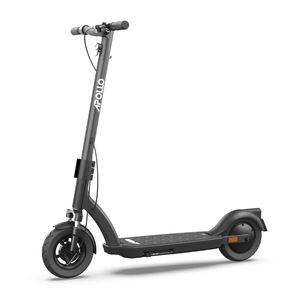Apollo Air Pro Review
18 mph
Speed
18 miles
Range
38.5 lbs
Weight
Just as we awarded the Apollo Air with the best-in-class ride quality sub $600, the Air Pro follows suit securing the crown for the sub $800 bracket. Replacing the ‘Apollo Light’ and superseding the more limited Air model, the brand new Air Pro cranks up its predecessor’s dial with superior specs, suspension, and stature. We often refer to INOKIM as producing some of the best-built electric scooters as a result of their precise manufacturing process, but just as INOKIM joins the components of its scooters with perfect alignment – forging unsightly seams that are all too common, especially on entry-level scooters – Apollo has done the same for the Air Pro. It eschews the clunky style that many scooters in its price bracket have with curved lines, flush finishes, and a design that flows from one section to the next. Bravo, Apollo.
$999.00 $799.00
*Offers displayed are from retailers that we trust. If only one offer is available this is because they are the only retailer we recommend. To support our rigorous scooter review and editorial process, we rely on affiliate commissions. These are at no cost to you. Our work is independent and impartial. Read more here.
Apollo Air Pro Review: 10 Things You Need to Know
Who is it Best For?
Will the Apollo Air Pro Be a Good Fit For You?
The Apollo Air Pro’s durable, dependable design and highly capable braking and suspension make it an excellent choice for commuters and as a premium entry-level scooter for first-time riders.
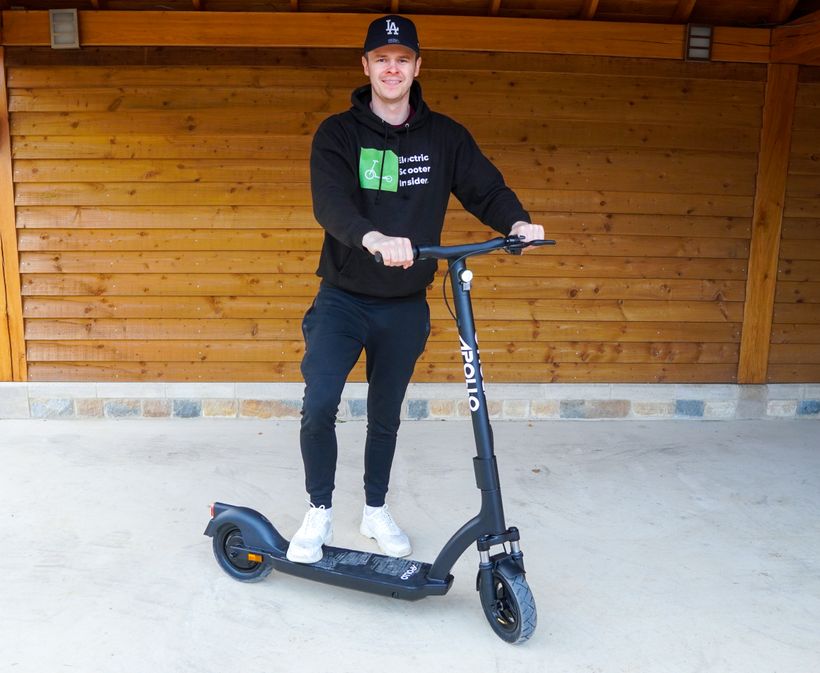
While it doesn’t sport the most powerful motors or the biggest battery when compared to similarly-priced models, it delivers a level of build quality that is unmatched.
Nimble, stable, and well-refined, the Air Pro is ideal for riders that want to turn the dial up on every aspect that its predecessor, the Air, has to offer. With a more powerful 350W motor and pacier top speed, a larger battery and extended range, and superior dual fork suspension to deliver superlative levels of comfort, the Air Pro heightens the enjoyment of weaving through city streets to deliver a ride that you won’t want to step off.
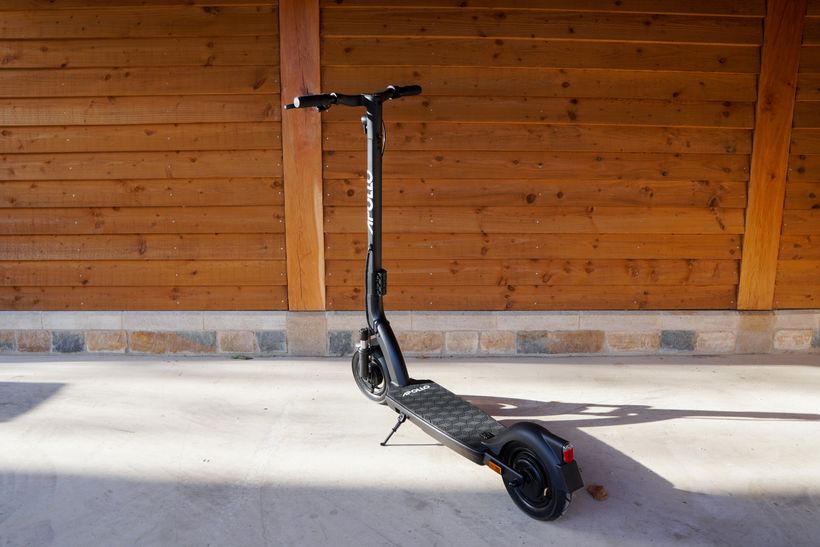
Pros and Cons
- Best-in-class ride quality under $800
- Sports a pair of 10-inch pneumatic tires
- Dual fork front suspension
- Good stopping power
- Intuitive display
- IPX4 water-resistance rating
- Excellent build quality
- Speed, range, and hill-climbing abilities pale in comparison to its closest competitors, but so does their build quality to the Air Pro
Value for Money
Is the Price Tag Worth it?
Whether the Air Pro is good value for money depends.
On the one hand, there are no other scooters under $800 that come close to how well it handles. This combined with what can only be described as a Rolls Royce level of build quality makes the Air Pro a reliable model that is well worth the layout.
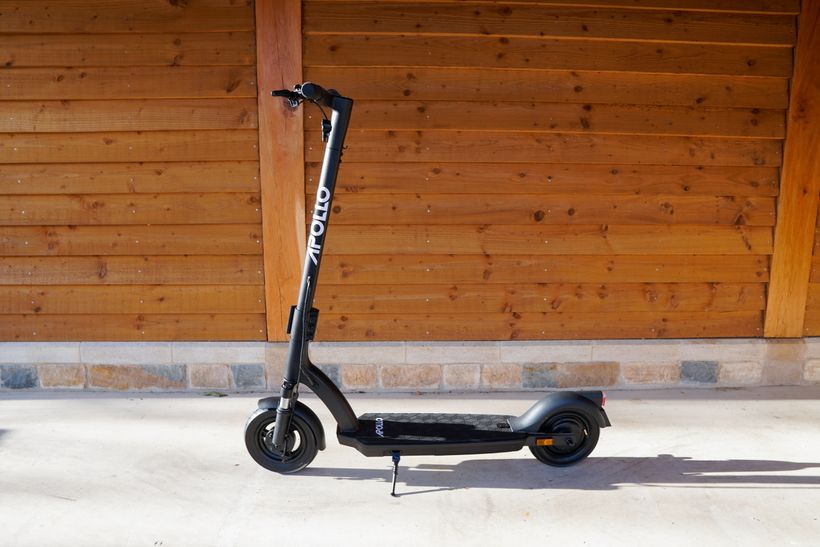
Plus, it's important to look past the exterior of scooters and – as is often the case – the embellished performance specs and instead pay tribute to what makes the scooter tick.
One of the most important components that can either make or – quite literally – break a scooter is the battery. With the Air Pro, build quality runs through its veins, and the Smart Power Management System is a lesser-known feature you should pay attention to. Not only does this system protect the battery from short-circuiting, overcurrents, and the ill effects of over-discharging, it also regulates its temperature and has undervoltage auto-sleep protection. All of this combines to ensure your battery remains healthy so that it can hold its peak performance for hundreds of charge cycles. It’s details like this that make the difference between buying a cheap scooter and replacing it. Everything about the Air Pro is built to last.
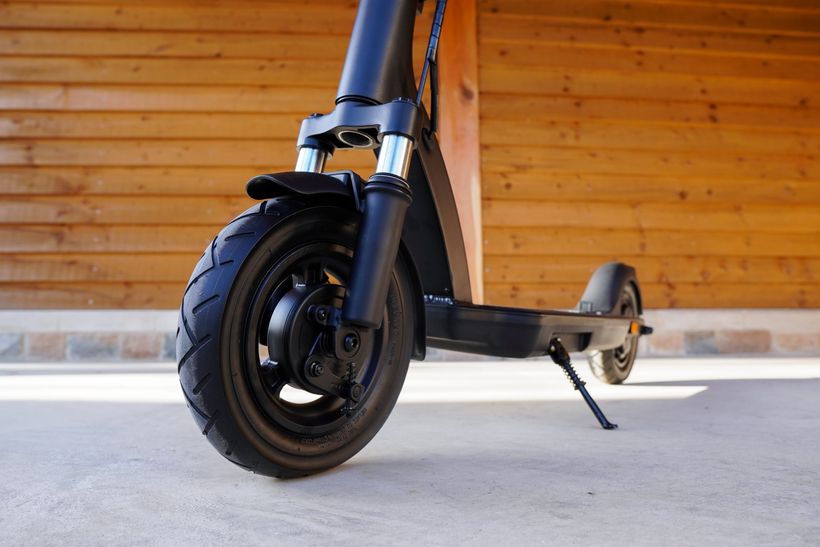
On the other hand, there’s no denying that there are similarly-priced scooters that outperform it for raw performance. For instance, open the price range to scooters that cost within $250 on either side of the Air Pro, and there emerge models that go toe-to-toe with it for ride quality but outpace it where speed, mileage, and portability are concerned. Take for instance the Horizon 13 – it sports front and rear suspension, a more powerful 48V 500W motor, and a larger 13Ah battery. The result is excellent ride quality, a top speed of 25 mph, and a maximum range of 25 miles (20-23 miles under realistic conditions). Plus, its multiple folding mechanisms – including a telescopic stem and foldable handlebars – afford it a portable design that the Air Pro can’t compete with.
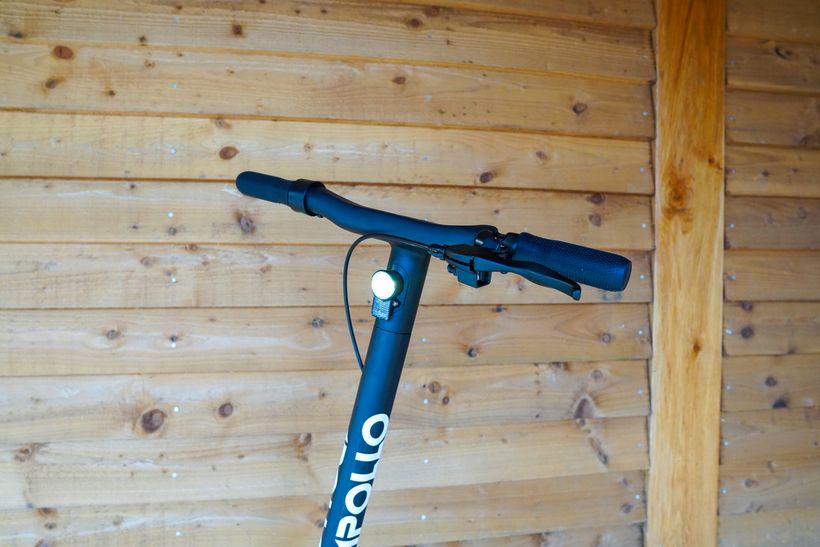
Ultimately, though, if you’re already stretching your budget to buy the Air Pro, then go for it – you won’t find a better scooter where build quality is concerned.
Alternatives
What Other Scooters Should You Consider?
Horizon 13
- Speed: 25 mph
- Range: 25 miles
- Weight: 42 lbs
- Load: 265 lbs
Why is it Better Than the Apollo Air Pro?
- Faster (+6 mph)
- 22% quicker acceleration rate
- More powerful 48V 500W motor (vs 36V 350W)
- Longer range (+7 miles)
- Supports more rider weight (+45 lbs)
- Telescopic stem and foldable handlebars for enhanced portability
Why is it Worse Than the Apollo Air Pro?
- Costs more (+$80)
- 49% less stopping power
Price:
- 879.00
GoTrax GMAX Ultra
- Speed: 20 mph
- Range: 45 miles
- Weight: 46.3 lbs
- Load: 220 lbs
Why is it Better Than the Apollo Air Pro?
- Larger 36V 17.5Ah LG battery (vs 36V 10.4Ah)
- Longer range (+27 miles)
Why is it Worse Than the Apollo Air Pro?
- Ride and build quality isn’t as good
- Heavier (+7.8 lbs)
- 33% slower acceleration
- 51% less stopping power
Price:
- 799.00
Turboant X7 Pro
- Speed: 20 mph
- Range: 30 miles
- Weight: 33 lbs
- Load: 275 lbs
Why is it Better Than the Apollo Air Pro?
- Cheaper (Save $150)
- Longer maximum range (+12 miles)
- Supports more rider weight (+55 lbs)
- Lighter (-5.5 lbs)
- Detachable battery pack
Why is it Worse Than the Apollo Air Pro?
- No suspension
- 22% slower acceleration rate
- 40% less stopping power
Price:
- 549.98
- Discount Code: Get $50 Off
Design
Handlebars
Flaunting a slender, slightly upswept design, the handlebars not only complement the look and feel of the scooter’s frame, but their wider-than-average 22-inch profile affords excellent handling.
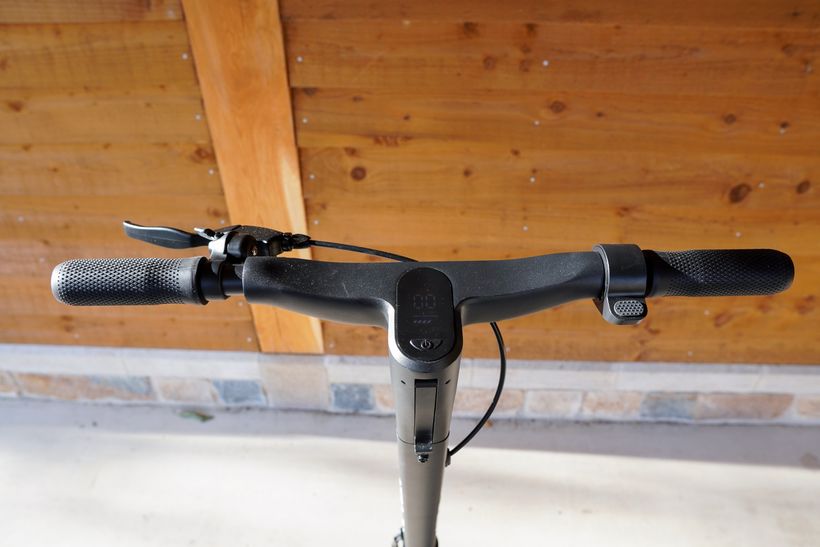
The handlebars are also where you’ll find the lever that operates the front drum brake, the thumb throttle, and, in the center, the main event that is the sleek LED display. I won’t spoil the surprise here (I’ll unpack this panel in greater detail in the ‘Extra Features’ section of the review), but suffice to say this thing is about as good-looking and user-centric as they come.
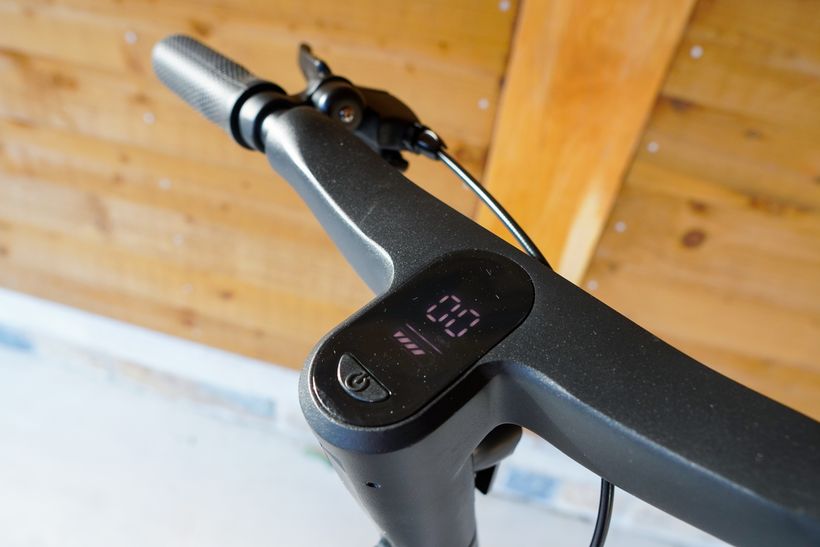
Frame
From a purely aesthetic perspective, there’s little to distinguish the Air Pro from its more basic counterpart, the Air. Both scooters eschew the clunky style that many scooters in their price bracket have with curved lines, flush finishes, and a design that flows from one section to the next.
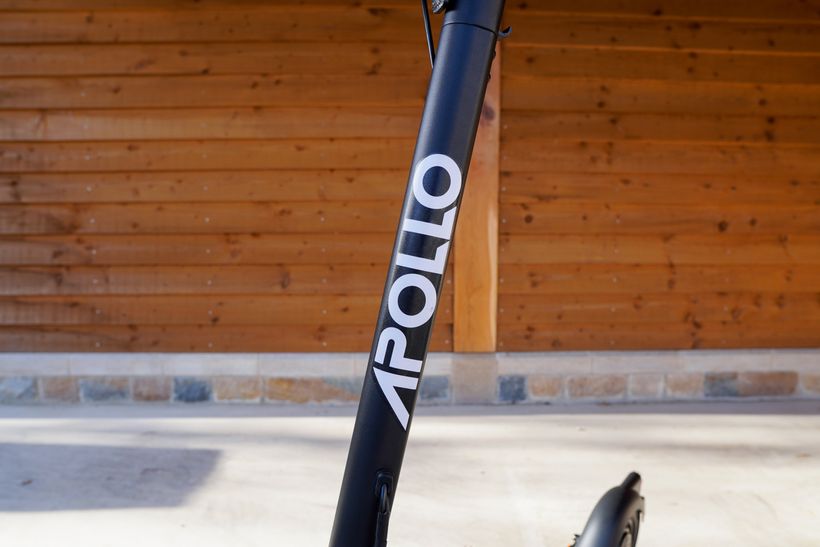
Its upswept handlebars and tapered deck are just a couple of the design quirks that create its streamlined, aerodynamic appearance. The Pro does manage to carve out its own look, though – replacing the spring at the base of the stem with a dual-pronged fork suspension that flanks either side of the front wheel for maximum cushioning.
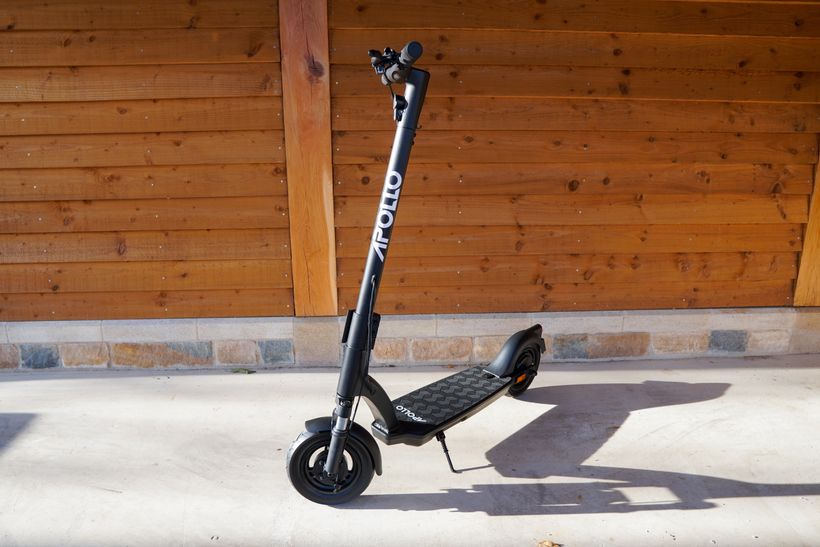
Despite challenging the status quo with its curving, classy composition, the Air Pro will please fans of the tried-and-tested scooter color scheme (black, black, and more black) with a monochromatic palette. It doesn’t just ride beautifully – it looks beautiful, too.
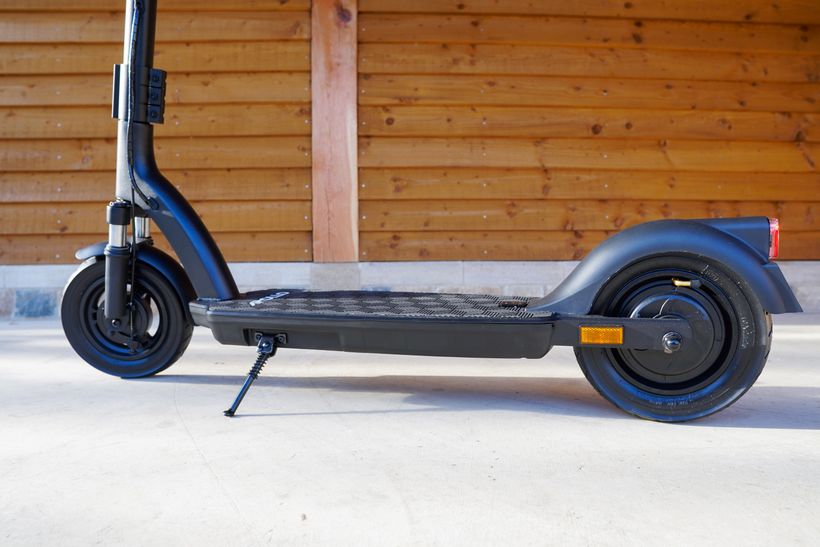
Deck
Built to a slim, almost longboard-esque specification, the deck compounds its stylish profile with plenty of substance. As well as housing the Pro’s battery (which gives the scooter a low center of gravity, and increases handling), the deck also improves on the amount of ground clearance the base Air provides by half an inch.
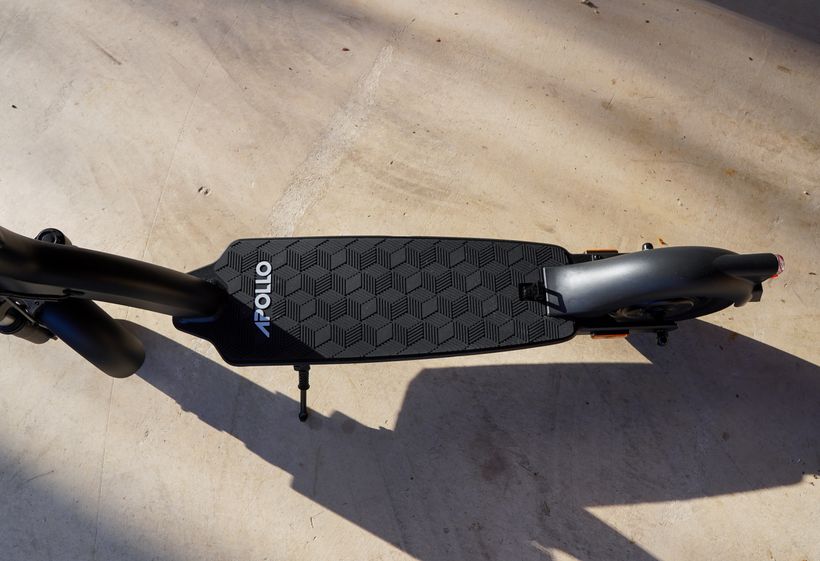
The Air Pro’s deck also comes slathered in a veneer of super grippy rubber. While this is a godsend as far as traction is concerned, the crisscrossing, geometric tread patterning doesn’t make it particularly easy to clean, and it’ll need scrubbing with a fine brush now and then.
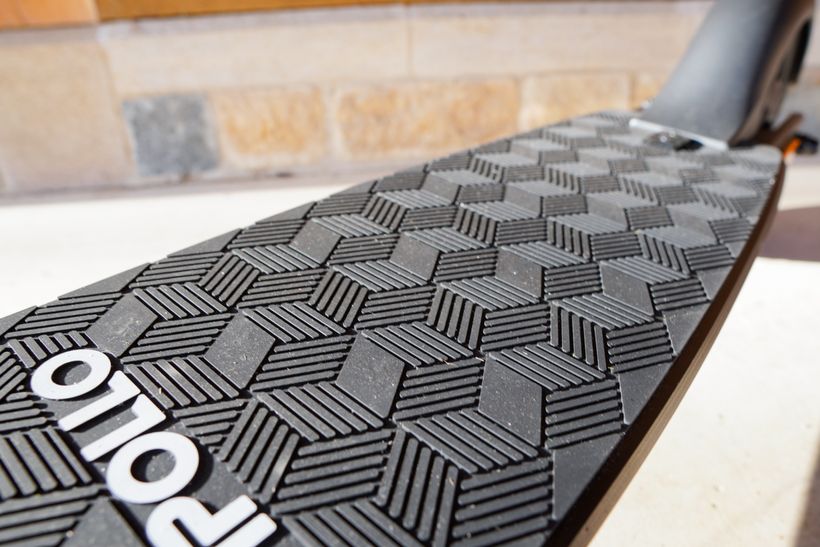
Wheels
In combination with its front fork suspension, the Apollo Air Pro’s dual set of 10-inch wheels do a great job of cushioning you from the impact of less hospitable urban terrain. They are even superior to those on its predecessor, given that the Air’s rear-wheel measures a smaller 8.5 inches.
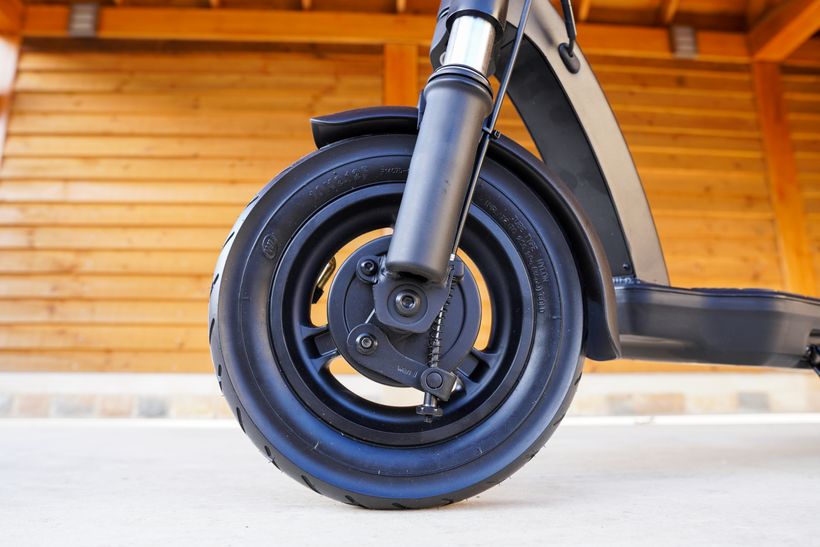
With a large profile rivaling that of many more expensive scooters – such as the EMOVE Cruiser and Apollo Explore – the large, luxurious tires mean you always have plenty of rubber meeting the road for maximum traction even when carving.
In comparison to scooters in its price bracket, only 10 out of the other 25 boast the same tire profile as the Air Pro, but the major difference is that the Pro is the only one to pair its tires with an effective suspension system. This is one of the key reasons why the Air Pro is able to deliver a supremely smooth-sailing ride.
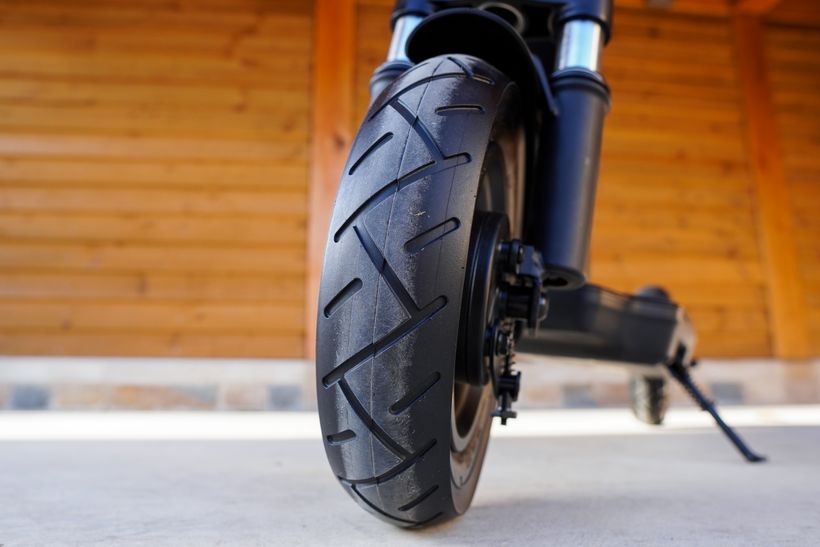
Build Quality & Durability
Alongside a durable, precipitation-hardened aluminum alloy that’s been used for the entirety of the frame and folding mechanism, hardened plastic is used for smaller components like the throttle and close-fitting rear fender while a durable anti-slip rubber coats the handgrips and deck.
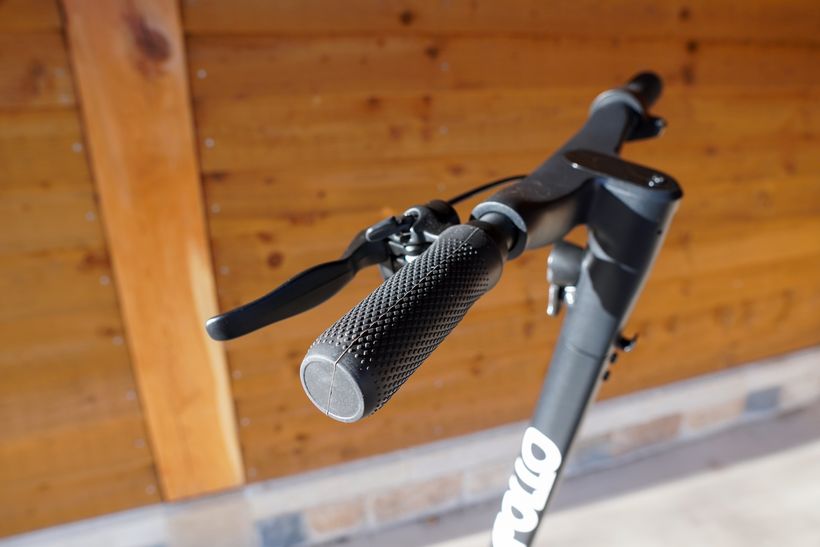
Just as I described the Air as having a Rolls Royce level of build quality, the Air Pro continues the theme. Apollo has really pulled this one out of the bag. I often refer to INOKIM as producing some of the best-built electric scooters as a result of their precise manufacturing process that uses CNC technology to cut out components from a single piece of aluminum alloy, but Apollo has come on leaps and bounds from its earlier models to build a scooter that I’d say is a match for quality against INOKIM. Just as INOKIM joins the components of its scooters with perfect alignment – forging unsightly seams that are all too common, especially on entry-level scooters – Apollo has done the same for the Air Pro. Bravo, Apollo.
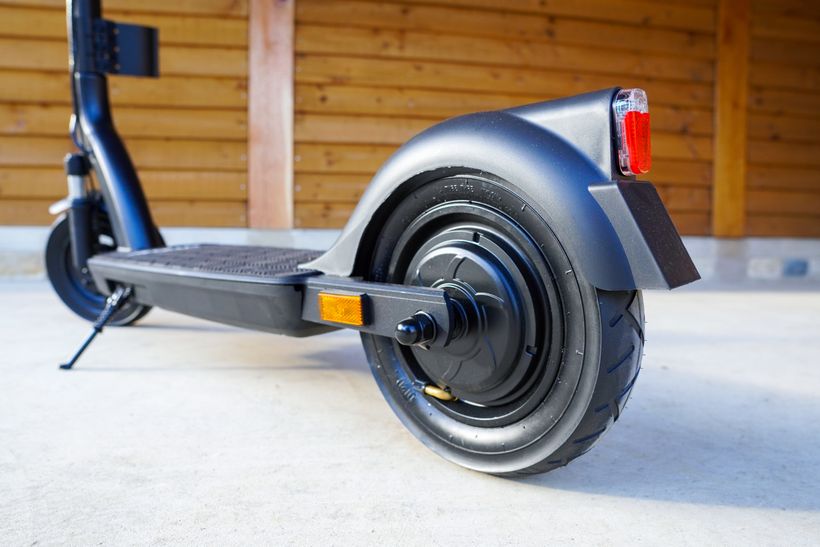
For example, you only have to look at the design of the folding hook that is kept flush to the stem in a magnetized cavity at the top of the stem, or the kickstand that retracts under the lip of the deck so it doesn't protrude out. Details like these portray the amount of thought that has gone into the Air Pro’s design.
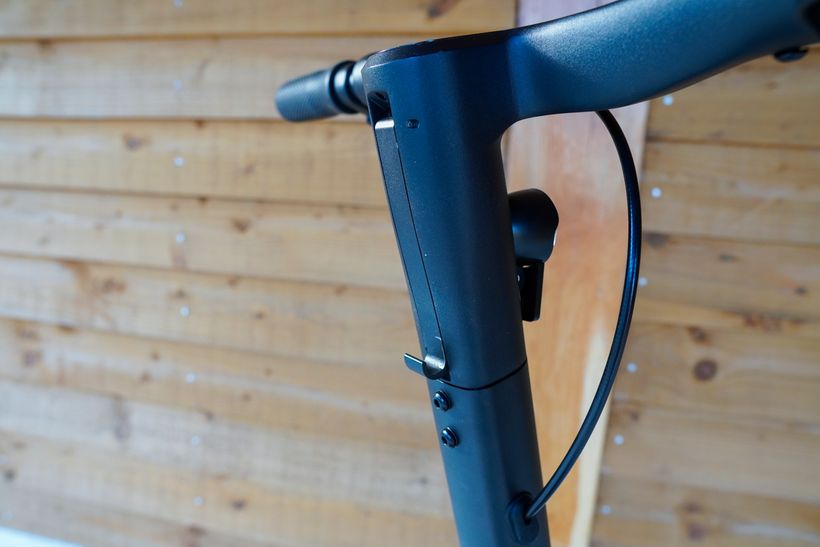
Here's the folding hook out of its cavity:
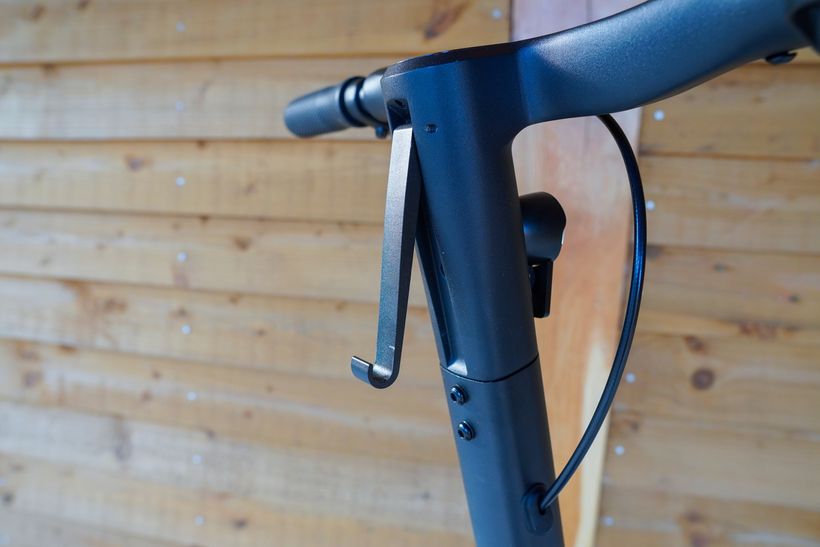
Weight & Load
The Apollo Air Pro weighs 38.5 lbs, meaning that – while it’s still within the 42 lbs maximum weight limit I place on commuter scooters – it’s certainly not the lightest, most compact scooter money can buy.
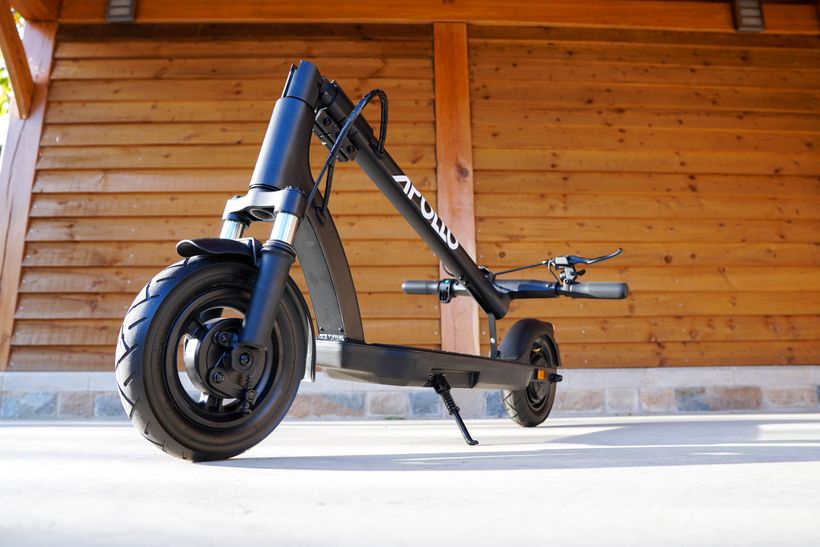
Some of the best lightweight alternatives to the Air Pro I’d be quick to recommend if weight is a key factor for you would be:
- Either the Turboant M10 (29.8 lbs) or the X7 Pro (33 lbs) – Both cost far less than the Apollo Air Pro and deliver good levels of overall performance.
- The INOKIM Light 2 (30 lbs) – Light by name and by nature, this beauty is the most portable scooter in the industry thanks to its small compact folded frame.
However, if weight isn’t the foremost of your concerns, then some similar weighing models boast enhanced portability which you can read about in the next section of the review.
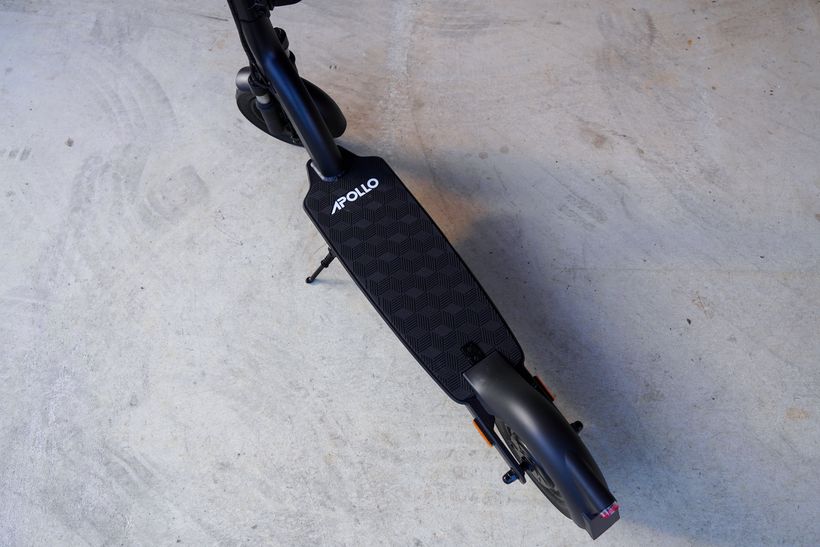
Load-wise, the Air Pro is capable of supporting up to 220 lbs of rider weight. This has become the standard for entry-level scooters, but I always recommend that you weigh 20-40 lbs less than the maximum capacity since the higher up the scale you are, the less performance you’ll get. If you require a scooter that can shoulder more, either the Horizon (265 lbs) or Turboant X7 Pro (275 lbs) will suit you.
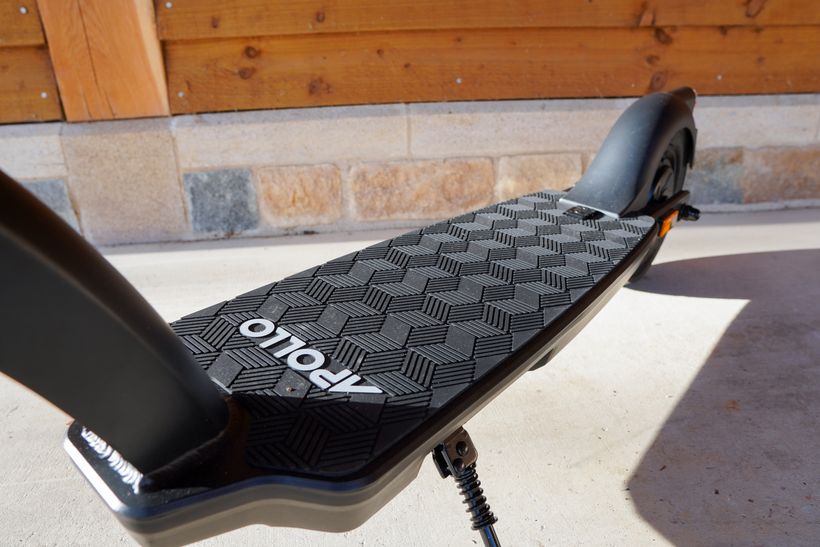
Folding & Portability
Another prime example of its fantastic build quality is its intuitive, hassle-free folding mechanism, which is made up of both a clamp and a quick-release lever. It looks a bit like three collar clamps stacked on top of each other.
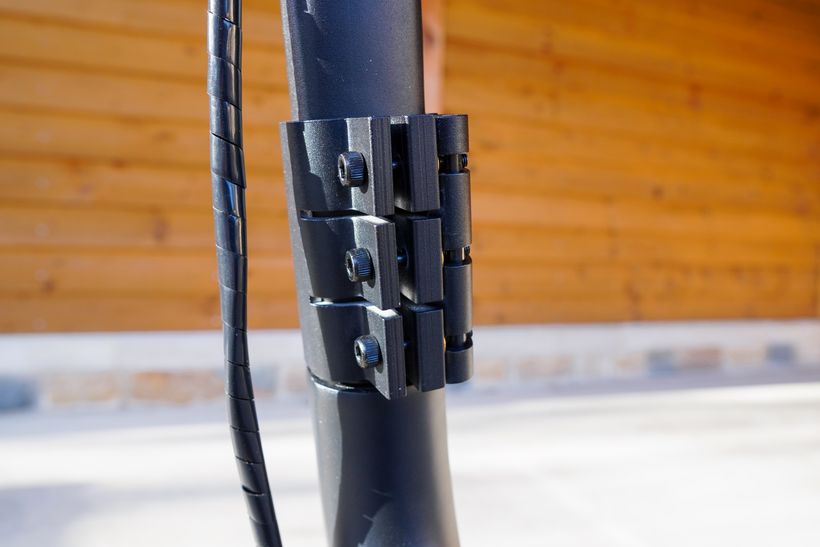
To fold the scooter, it’s a simple case of pulling the lever back, then lifting the clamp to expose the folding joint, and collapsing the stem down to the deck.
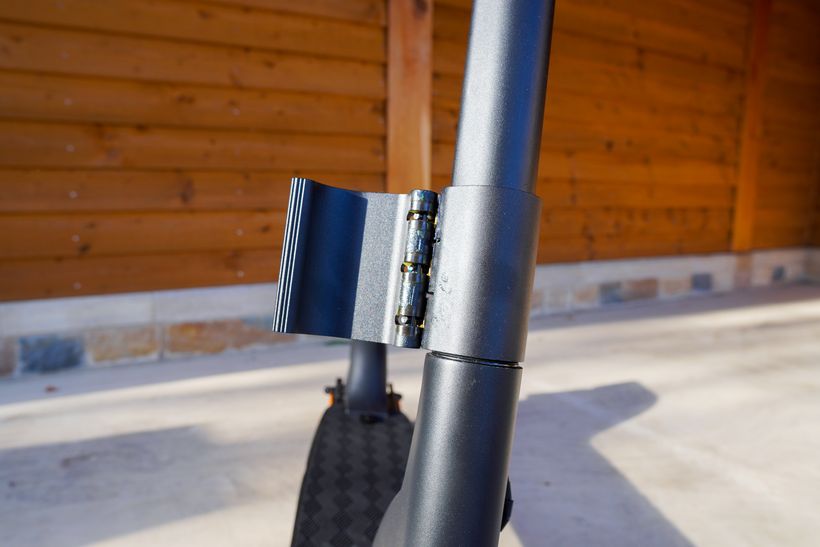
Once the stem is parallel to the deck, you can fasten the two together via a simple-yet-ingenious hook-and-latch combo. Because of this, the Air Pro is easy to lift and carry around, without the risk of the scooter coming unfolded while in transit. This is an issue with some similar models (the Turboant X7 Pro comes to mind), so it’s refreshing that there are no such worries with the Air Pro.
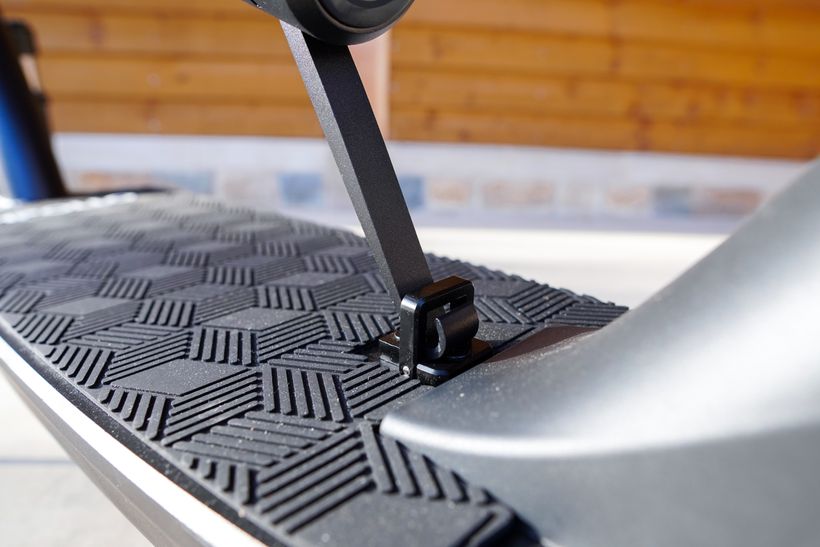
However, while the scooter benefits from an effective stem and deck locking mechanism, one area that hinders portability is the handlebars. Because they are 6-7 inches wider than the typically entry-level scooter, they give the Pro a wider folded profile. This isn’t a major issue if you have the space to store it or if you’re careful maneuvering it while carrying the scooter but if you want to benefit from a truly portable model, you may want to opt for the Horizon 13. With a telescopic stem and foldable handlebars, the Horizon’s folded size is significantly reduced. For example, the Horizon measures 38.6 (L) x 7.1 (W) x 14.6 (H) inches when folded. In comparison, the Air Pro measures 46.8 (L) x 22.0 (W) x 20.9 (H) inches.
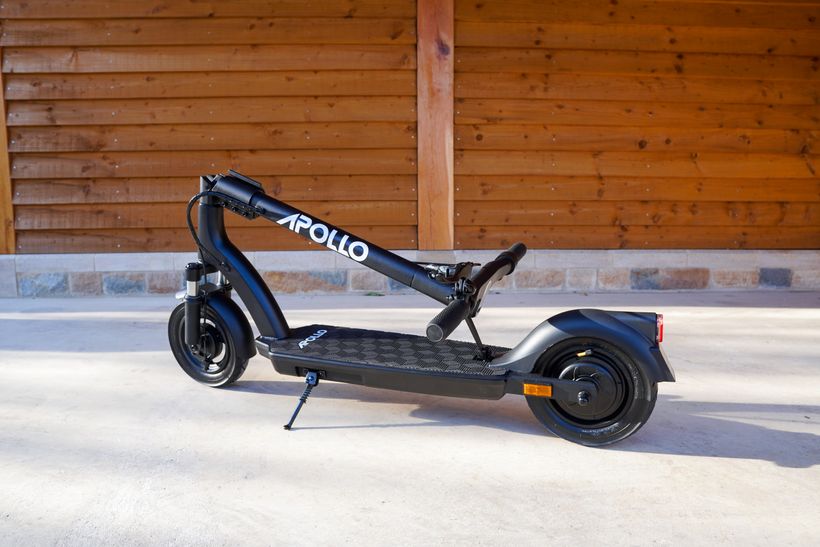
A Guide to Foldable Electric Scooters (Lightest & Most Compact)
Assembly
It arrives 90% assembled. Your main job will be to mount the handlebars atop the steering column, connecting a couple of cables as you do so. Fasten the handlebars into place with the screws included and you’re good to go.
The manual is your friend here – it comes in the box, and you can also access a digital copy online.
Ride Quality
Is the Apollo Air Pro Comfortable to Ride?
In my review of the Apollo Air – the version the Air Pro builds on – I dubbed it “a pleasure to ride”. Considering the Air Pro increases the size of the base Air’s rear wheel – and swaps out its single spring for a more effective front fork setup – it’s fair to say the Pro delivers an even smoother ride. In fact, it has the best-in-class ride quality sub $800.
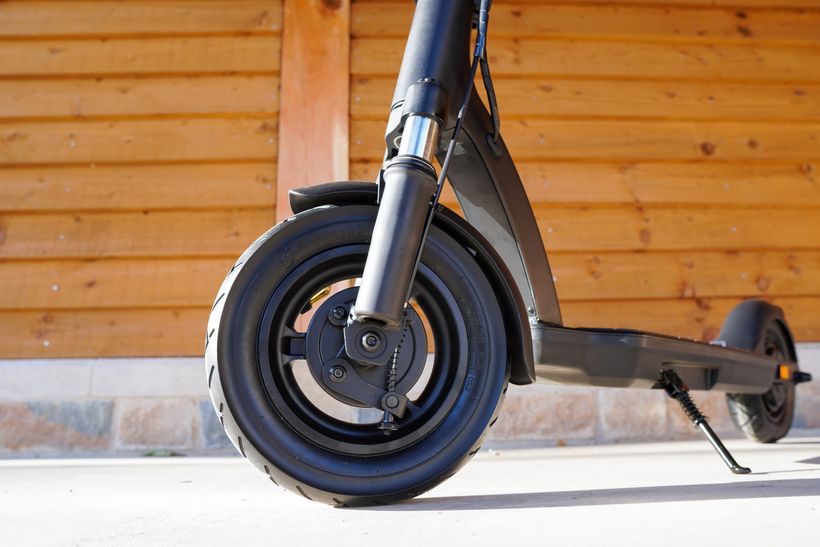
While its shock-absorbing tire and fork combination work in harmony to soak up rough terrain – like a memory foam bed molding to your body – the rubber deck keeps your feet firmly pinned and wide handlebars make riding the Pro as smooth as Michael Jackson's moonwalk.
To get the best from the Pro, urban environments are where it is at home.
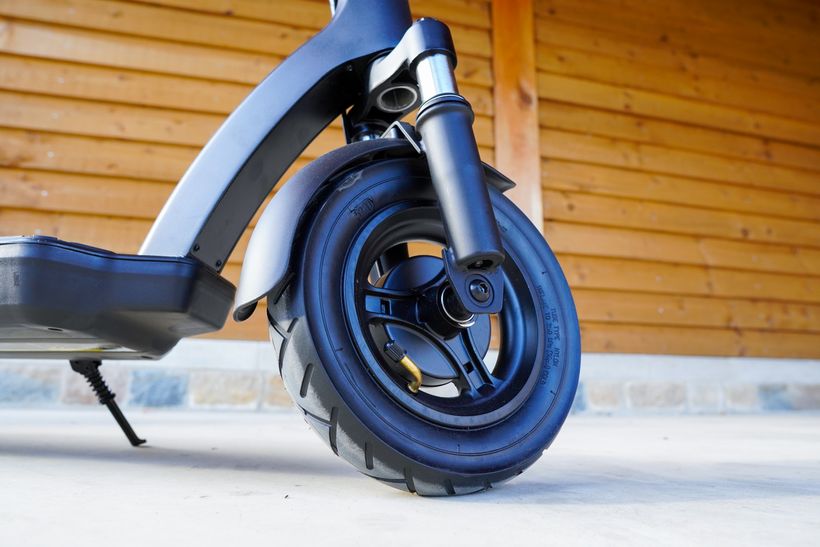
Performance & Safety
Speed & Acceleration
With a top speed of 18 mph, the Apollo Air Pro adds a 20% page injection to its predecessor. But, of course, that comes at the cost of an extra $150 – so how does the Air Pro stack up against scooters that are more comparable in terms of price?
Speed vs Price Comparison
To find out, let’s apply a $500 price range, with the Air Pro’s $799 price tag in the middle. This gives us a total of 25 models with which to compare to – so how does it fare?
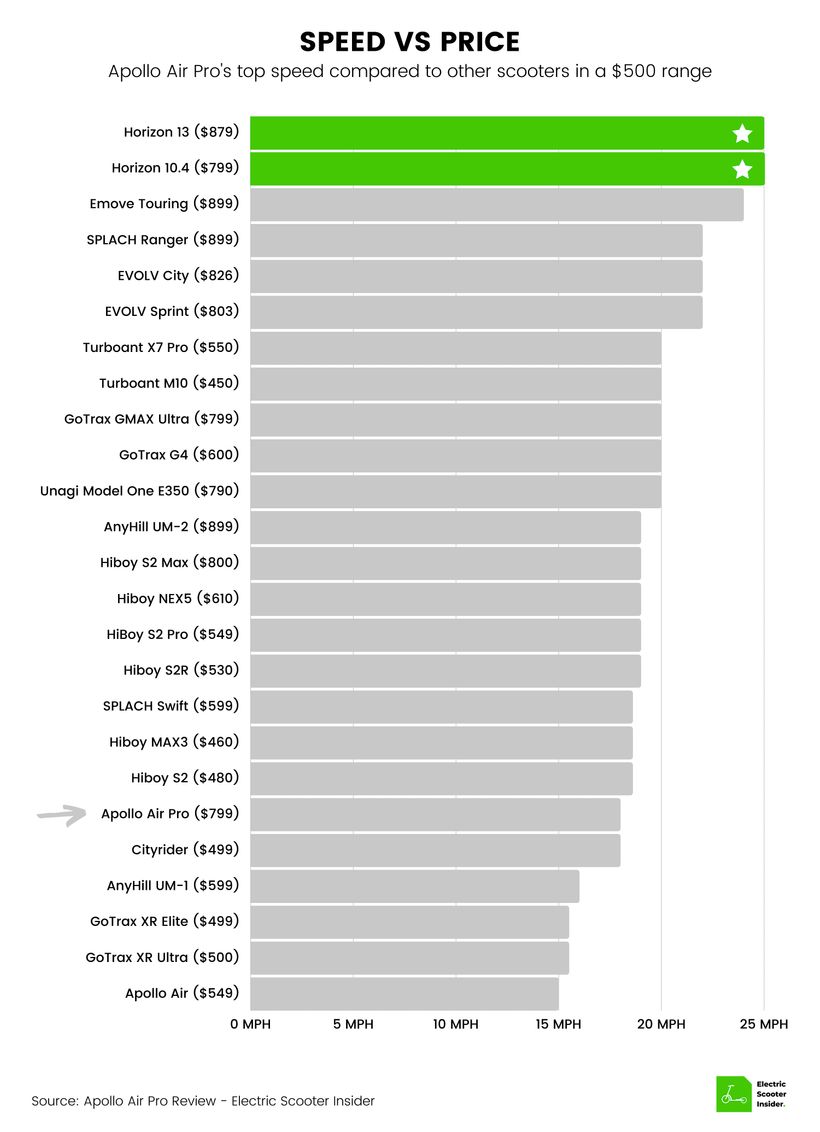
Averagely. The Air Pro’s relatively mediocre top speed of 18 mph places it in the lower end of the rankings, keeping company with the likes of the Hiboy MAX3 (18.5 mph), and Cityrider (18 mph).
The only real consolation here for the Air Pro is that its build quality is superior to these other models, and while it may not secure a podium position, its ride quality at top speeds outperforms the majority of scooters that come before it.
Casting our eyes up to the opposite end of the table, it’s two speedsters sharing the summit: the Horizon 13 and Horizon 10.4. Thanks to their larger and more powerful 48V 500W motors, each of these can hit tarmac-tearing speeds of up to 25 mph. The popular EMOVE Touring – a compact number, which combines pace with portability – comes a close second, with an impressive 24 mph top speed.
Speed vs Weight Comparison
Leaving price behind, let’s take all of the 14 scooters in the Air Pro’s 33.5 to 43.5 lbs weight range (that’s 5 lbs on either side of the Pro’s 38.5 lb heft), to see how its speed compares to the other models in that bracket.
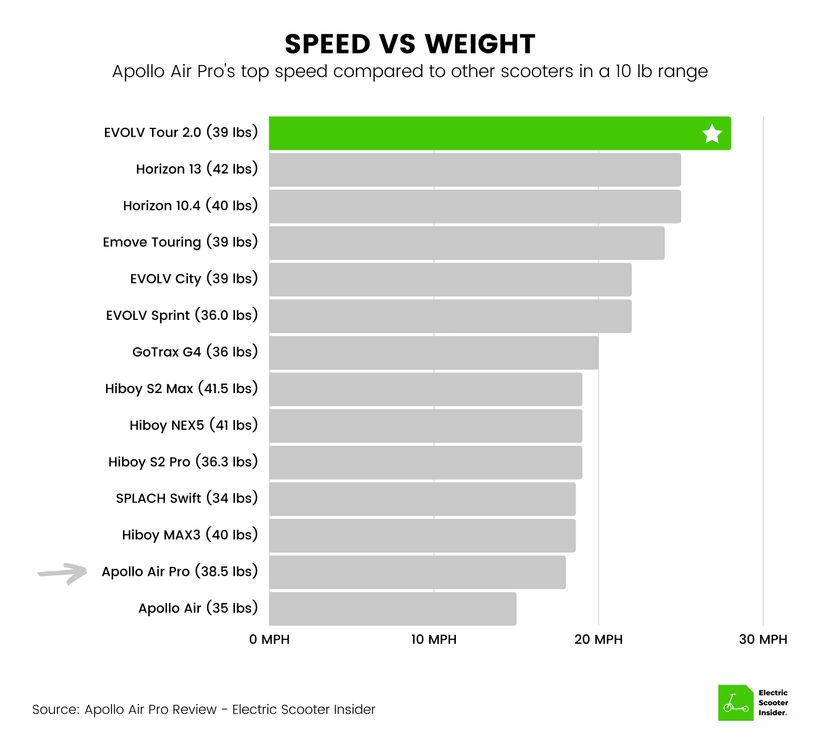
Unfortunately for the Air Pro, things aren’t looking too good. The low-table ranking it claimed in the Speed vs Price comparison continues in our Speed vs Weight chart. Ironically, the only scooter to place lower than the Air Pro in its weight class is its little bro. So, while both these brand new Apollo scooters look good and ride comfortably, neither are suitable for riders seeking the adrenaline hit that only a fast scooter can provide.
Speed freaks, take note – for a scooter with a similar build and weight to the Apollo Air Pro, but a far higher top speed, the EVOLV Tour 2.0 is your best bet. The EVOLV’s 600W motor is 71% larger than the Pro’s and as a result, it can hit the heady heights of up to 28 mph – a crushing 10 mph more than what the Pro is capable of.
Be warned, though – that extra velocity comes at a price. The EVOLV isn’t too far off being double the price of the Air Pro, so it may not be the best option if you can’t stretch your budget this far. Alternatively, the Horizon 13Ah makes for a fantastic alternative.
Acceleration
Able to hit 15 mph in 6.0 seconds flat, the Apollo Air Pro is no lazybones when it comes to accelerating. Despite boasting the same size motor as the Turboant X7 Pro and GoTrax GMAX Ultra, the Air Pro’s rear-wheel-drive allows it to shave a full 1.3 seconds off the X7 Pro’s acceleration and 2.0 seconds off the GoTrax.
| Scooter | 0-15 MPH (Seconds) |
|---|---|
| Horizon 13 ($799) | 4.7 |
| Apollo Air Pro ($799) | 6.0 |
| Turboant X7 Pro ($550) | 7.3 |
| GoTrax GMAX Ultra ($799) | 8.0 |
Considering that the motors in both the Turboant and GoTrax motor are located in the front wheel, the Air Pro’s faster acceleration makes sense. After all, front-mounted motors are notorious for slower accelerations than rear-mounted ones.
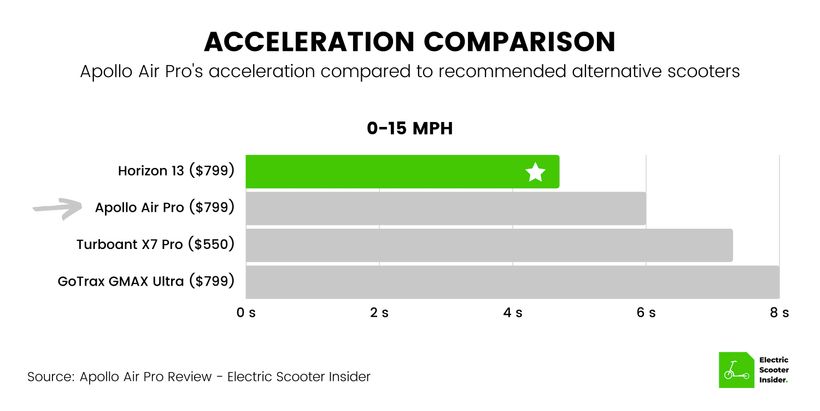
Its victory over the these models notwithstanding, the Air Pro’s acceleration rate still pales to that of the Horizon, which is capable of hitting 15 mph in 4.7 seconds. The Horizon accelerates 1.3 seconds faster (or 22% quicker) than the Air Pro, so it’s your guy if zippy acceleration is high on your wishlist.
Range
The Apollo Air Pro has a manufacturer-stated maximum range of 18 miles. Right about now, I would tell you what this equates to in real-world usage – usually, you can expect a 35-40% decline in these stats because they are based on a 165 lbs person riding the scooter in its lowest speed setting across flat terrain – though, in this case, 18 miles is exactly what you get.
How does the maximum range compare to scooters in its price and weight class? Let’s find out.
Mileage vs Price Comparison
Replicating the comparisons above – but this time focusing on mileage, rather than speed – gives us a total of 25 models in the Air Pro’s pricing class. And again, the Air Pro’s results seem shrug-worthy, with a middle of the pack ranking.
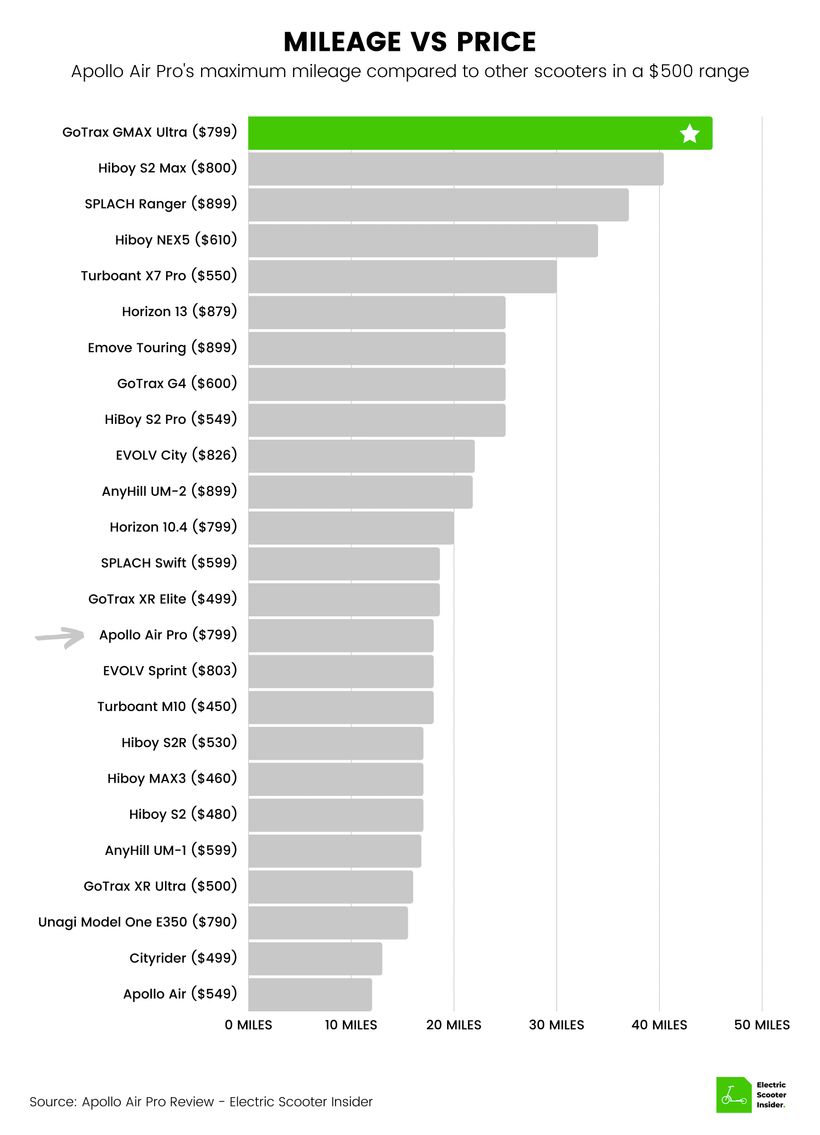
However, it is worth noting that Apollo doesn’t inflate the specs of their scooters. Instead, you get what’s promised. With this in mind, under realistic riding conditions, it goes toe-to-toe with models that are higher up in the rankings like the Turboant X7 Pro, whose maximum sits at 30 miles but realistic mileage clocks in at 16-17 miles. The X7 Pro does comes with a detachable battery pack, though. This savvy design feature allows you to replace the battery with a new one while you’re out on the road, thereby doubling your range.
Topping the rankings is the distance powerhouse of entry-level scooters – the GoTrax GMAX Ultra. With a top range of 45 miles, this high performer offers statistically the best range in its pricing bracket. Plus, with a high-quality 36V 17.5Ah LG battery on its side, it is able to store 68% more energy (630Wh vs 374Wh).
That said, the GMAX Ultra does lack suspension – meaning that its ride quality isn’t as smooth as the dual fork-equipped Air Pro.
Mileage vs Weight Comparison
As seems to be the trend with the Air Pro’s specs, its 18-mile range sits in the lower end of the rankings.
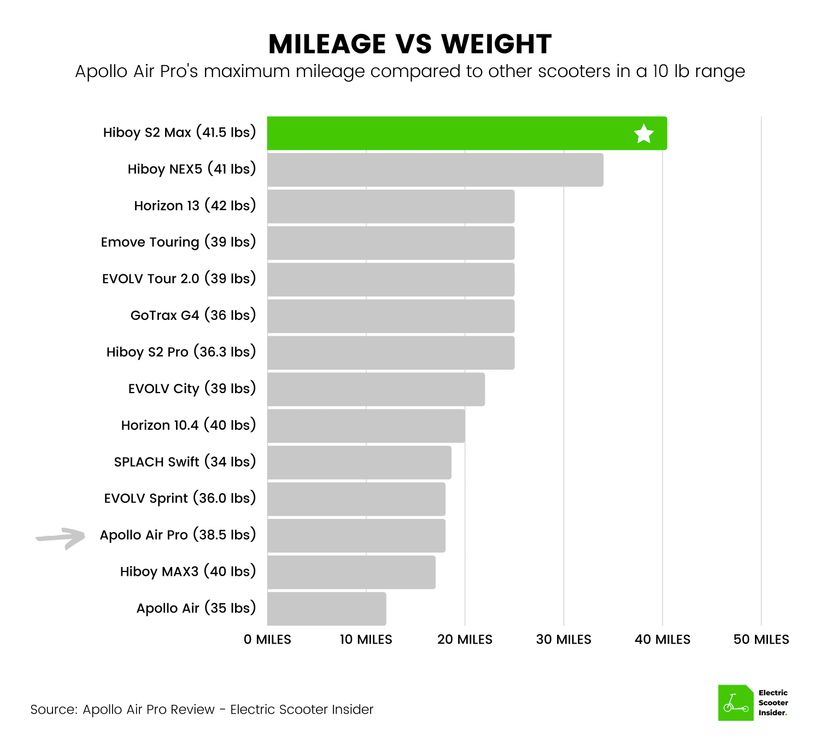
This time, it’s the Hiboy S2 Max taking the crown. While this model flaunts large 48V 11.6Ah battery, I would suggest opting for the previously mention GoTrax GMAX Ultra if a long range scooter is what you are after. Although the GMAX Ultra doesn’t make it into the weight comparison, it is, after all, only 4.8 lbs heavier than the Hiboy S2 Max. The additional weight is a small price to pay when you consider the larger battery that the GMAX Ultra has to offer. Not to mention the high-quality LG cells, as well as it sharing the same $799 price tag.
Hill Climbing
Despite boasting a motor that’s 100W larger than the base Air model, the Air Pro doesn’t add any extra hill-climbing power to its little bro’s capabilities. Like its cheaper counterpart, the Air Pro can tackle hills of up to 10 degrees.
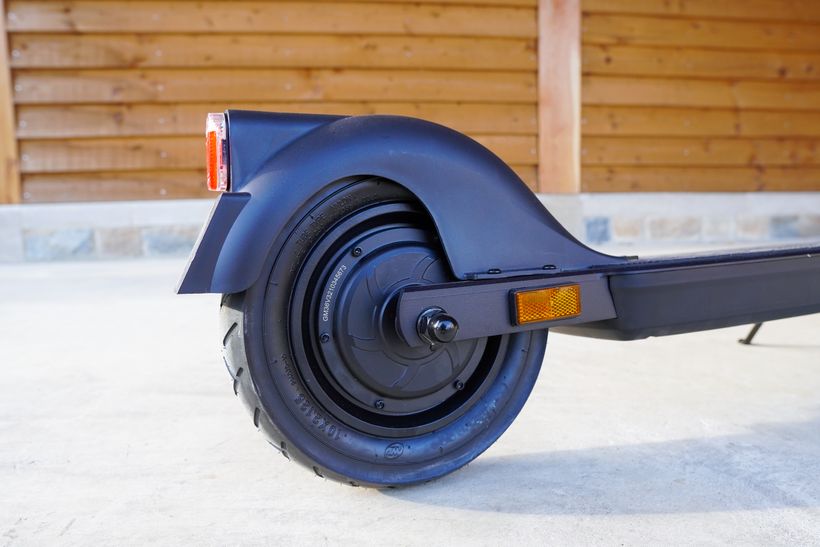
Its hill-climbing capabilities are average for its 350W motor.
Electric Scooters For Climbing Hills: Breeze Up the Steepest of Inclines
Shock Absorption / Suspension
The Air Pro shows the pedigree of the Apollo brand when it comes to the quality of its suspension.
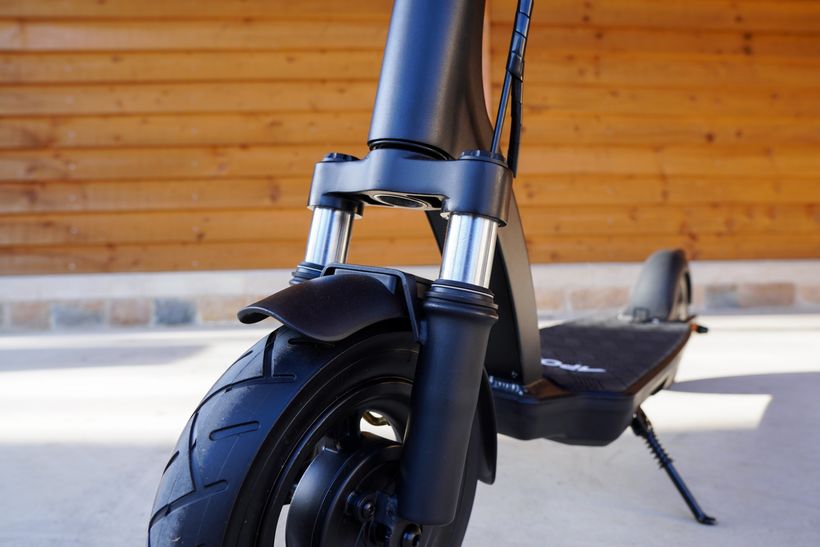
Exhibit A? The dual fork over its front wheel. While it may look like a miniature version of the motorcycle-grade inverted hydraulic shock absorbers on the Wolf Warrior, it has more in common with that of a mountain bike, using a spring in either side of the fork.
An upgrade from the Air’s single spring, and similar to the dual-pronged setup of the EMOVE Touring, the fork isn’t just an excellent addition to the scooter – it’s a rare one, too. The Air Pro is one of few entry-level scooters to sport fork suspension – the only similar model to do so is the Inmotion L9.
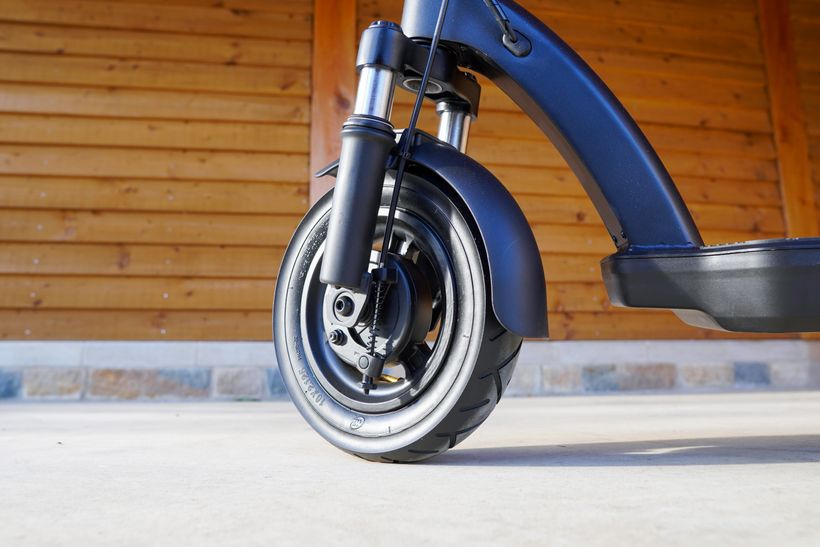
Braking
The Air Pro derives its impressive stopping power from a front drum brake, backed up by an electronic regenerative braking system at the rear.
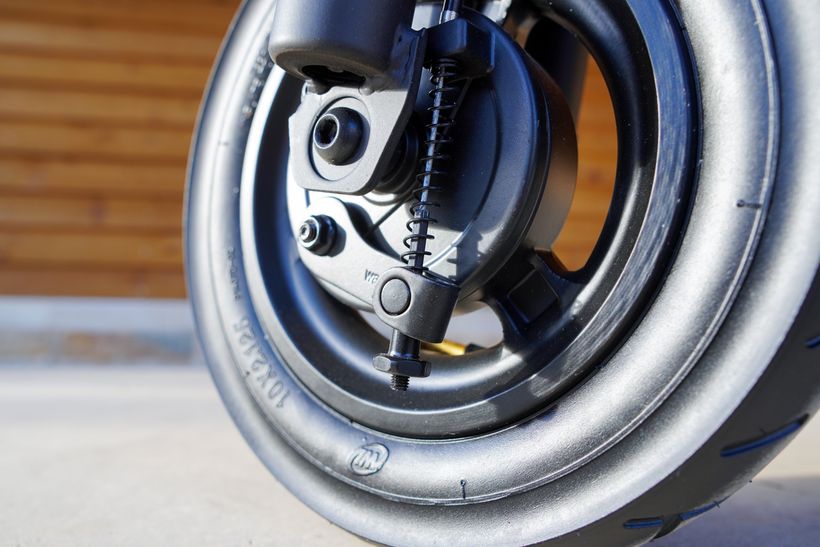
Firstly, it’s worth noting that the Pro’s braking performance is far better than that offered by its predecessor, the Air. That model directs all of its stopping power to its rear wheel with a mechanical disc brake and regenerative system. The Pro improves on this by moving its mechanical brake – in this case, a drum – to the front wheel while routing its regenerative system to the rear. This spreads out the stopping power, funneling braking ability to both wheels, rather than just one.
As you can probably guess, all this technical stuff is very much born out in the braking performance of these two respective models. The Air Pro comes to a stop in around 3.5 meters from 15 mph – comfortably outstripping the Air’s more sluggish 5.2 meters.
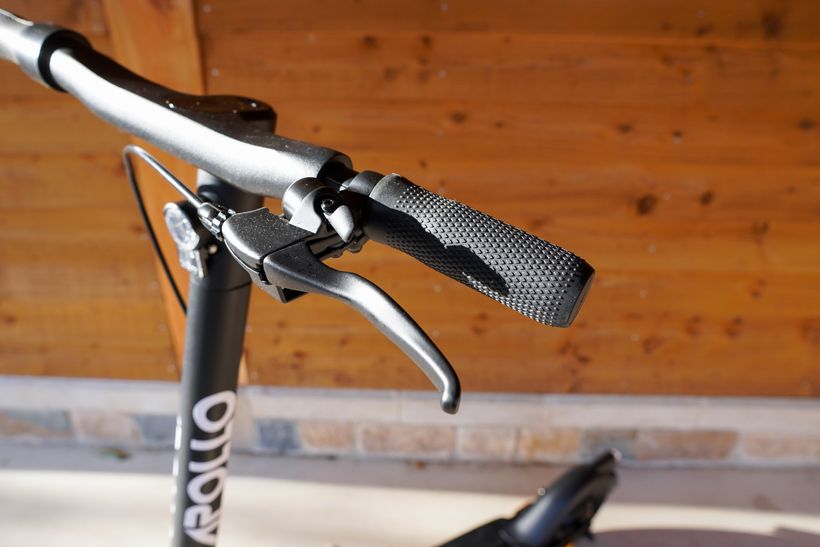
The Air Pro’s dual wheel braking system allows it to even trump the braking power of the top models of its ilk, such as the Horizon – which possesses a single drum brake over the rear wheel.
As far as braking performance is concerned, the Air Pro more closely resembles the Apollo City 2022’s 3.4 meter stopping distance.
Charge Time
The 36V 10.4Ah battery takes 5.2 hours to charge.
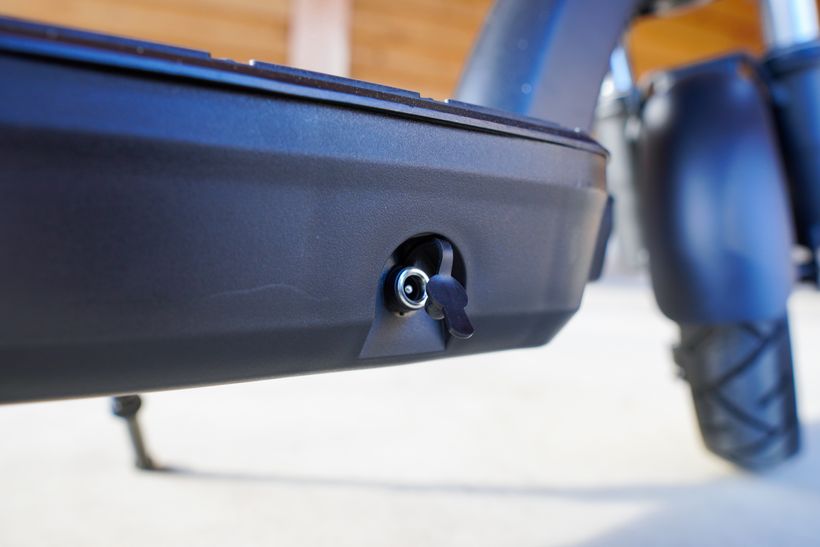
You’ll know when the scooter is charging by the red light that appears on the charger – this will turn green when it’s fully juiced up.
The charging ports are covered by a protective cap to ensure that no water gets in and messes with the circuitry.
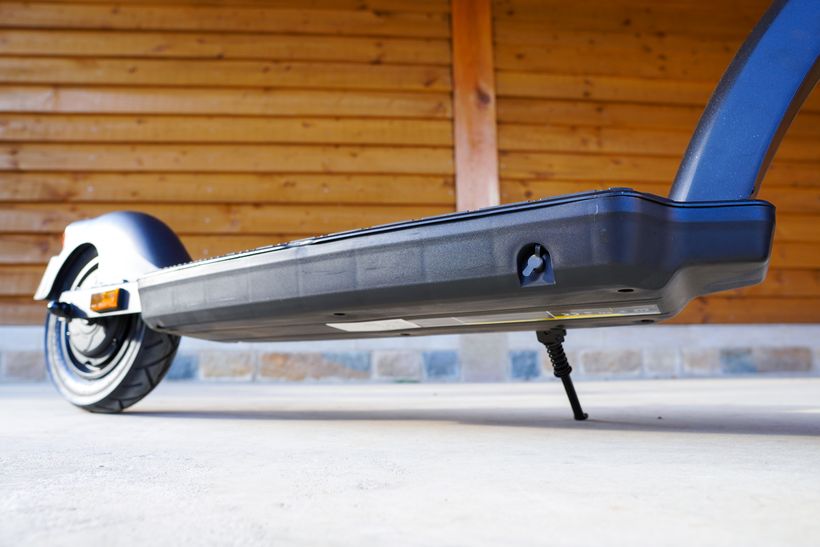
Extra Features
LED Display
Centered between the handgrips, you’ll find the unique, integrated LED display. Here, you’re able to monitor your speed and battery capacity, as well as activate your lights, toggle the cruise control on or off, and stay in the loop about any issues with your scooter, in the form of error codes.
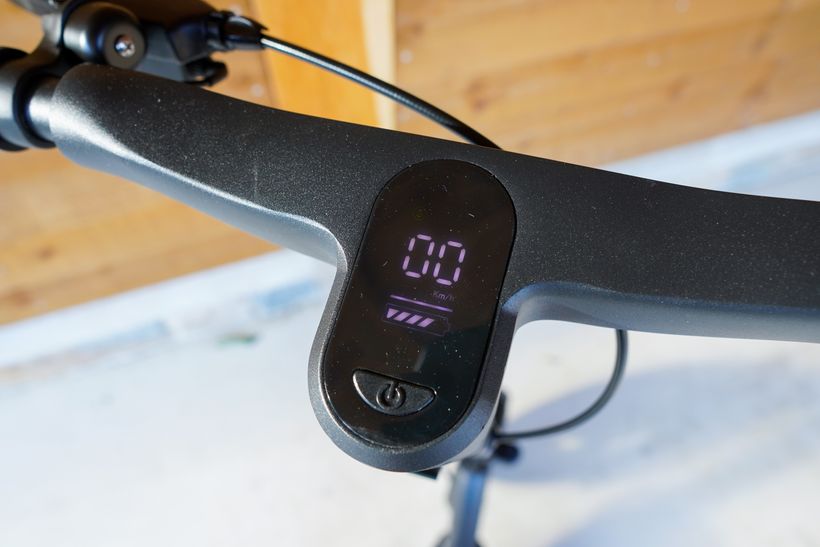
The display screen – which can be turned on/off via a small button located below the panel – also allows you to toggle between the scooter’s trio of riding modes. Via these modes, you can place limits on the speed at which your Air Pro can travel at:
- ‘Walk’ mode will cap your speed at 4 mph
- ‘Normal’ mode limits you to 11 mph
- ‘Sport’ mode does away with the limits, giving you a license to hit the 18 mph top speed
You’ll be able to monitor which riding mode you’re in via a series of indicator icons on the screen. ‘Walk’ mode has no indicator, while a green ‘S’ will appear in ‘Normal’ mode and a red ‘S’ in ‘Sport’ mode. Other icons will pop up to display the status of the lights and cruise control.
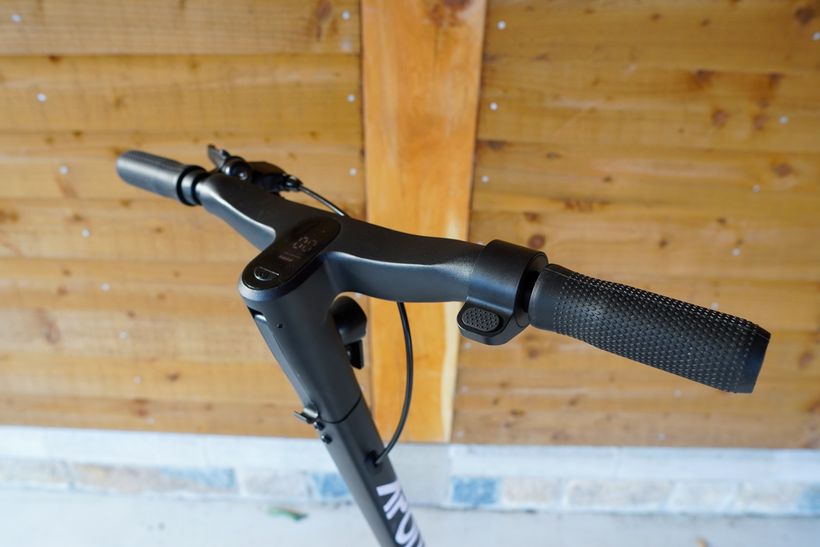
The screen – which, thanks to its black, bezel-less surface, merges almost unnoticeably with the scooter’s handlebars – is a testament to the build quality and design of Apollo’s scooters. Sure, it’s never going to plumb the depths of customizability that the more premium QS-S4 and MiniMotors EY3 finger throttle/display screen combos are capable of. However, I don’t expect entry-level scooters to offer this – particularly because they can’t match their more expensive counterparts for specs or performance.
Plus, the lack of a QS-S4 or EY3 display means the Air Pro isn’t hamstrung by the less ergonomic finger throttles those devices come with. The Pro’s thumb throttle is one of the more comfortable varieties, which – like its display – is both intuitive and pleasant to use.
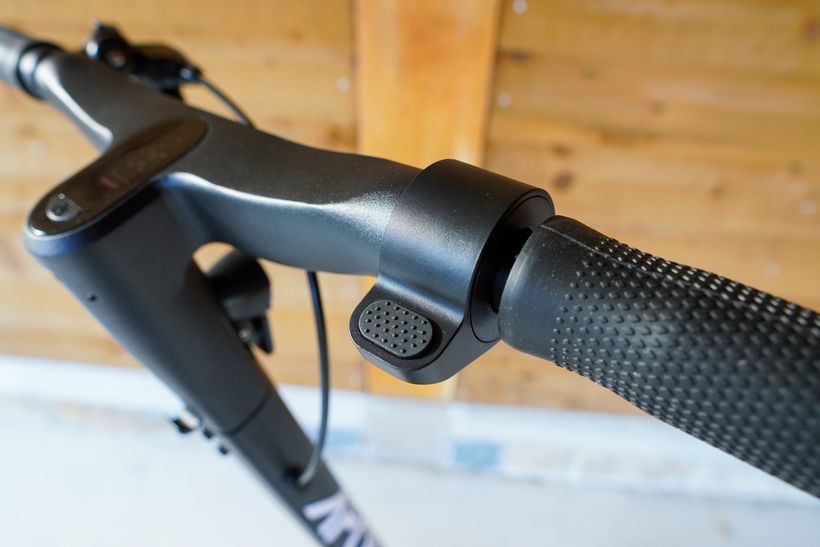
Cruise Control
You have to short press the button below the display screen three times to turn cruise control on. You’ll know it’s on when a small icon shaped like a speedometer located in the lower right-hand corner of the display lights up. Engaging it allows you to maintain a constant speed, without having to keep the throttle depressed in perpetuity.
It’s a handy feature, but unlikely to be for everyone. To turn it off, simply press the same button again three times in quick succession.
Bell
This one’s fairly self-explanatory. The bell is the same as that you’ll see included on the base Air model. Having a bell (particularly one that’s effective) is ideal for letting pedestrians and traffic know you’re coming through. This one is sufficient for the former but not the latter.
Bag Hook
As discussed earlier, there’s a small hook located at the top of the stem. While its main purpose is to lock into the ring-like mechanism on the deck – thereby ensuring the scooter remains a single, stable piece when folded – it also serves an ancillary function when unfolded.

Namely, this hook can be used to hang your bag on. Although I don’t recommend using it for this purpose since it can make the scooter top-heavy and be the cause of accidents since the side-to-side swaying of a bag hinders control over the handlebars and steering column.
Headlight and Taillight
The Air Pro sports a headlight and responsive tail light. Both are a little more dynamic than the LED setups you see on other similarly-priced scooters.
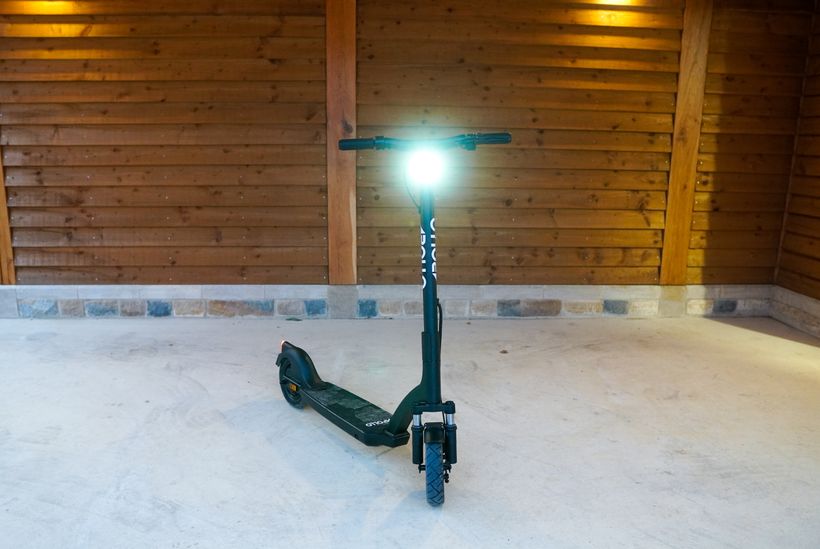
The headlight, for instance – which is located high up on the stem for optimal visibility – is also adjustable. You can tilt it upward or downward to get the right angle of sight, and there’s even a reflector positioned just below it.
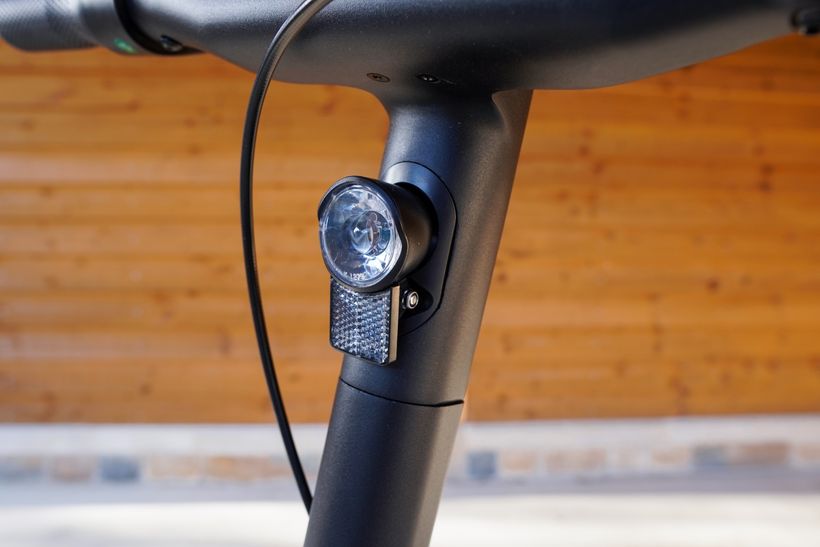
At the scooter’s rear, the fender-embedded tail light stays on while you ride – a plus you don’t see on all models, with the Kugoo G2 Pro serving as a glaring example. It also flashes when you hit the brakes.
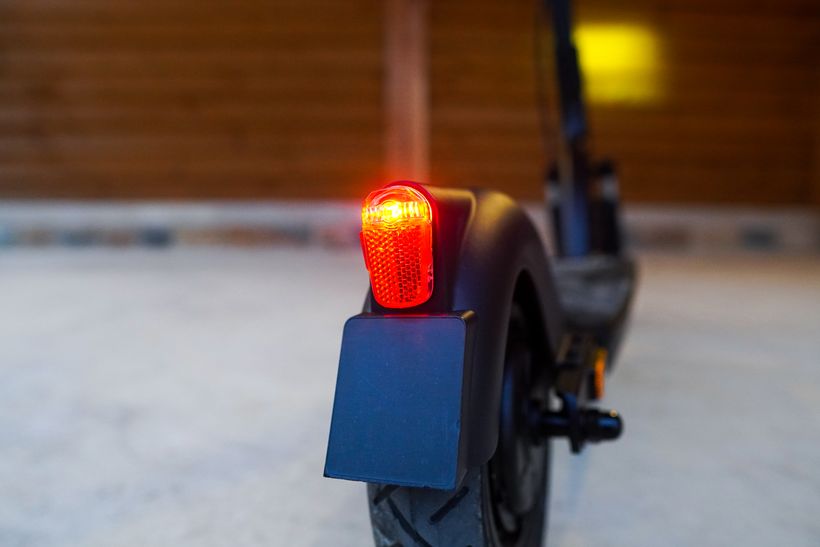
Not one to miss out on the reflective action, the rear of the scooter also includes a pair of reflectors, which – located on either side of the wheel – add an extra dash of visibility.
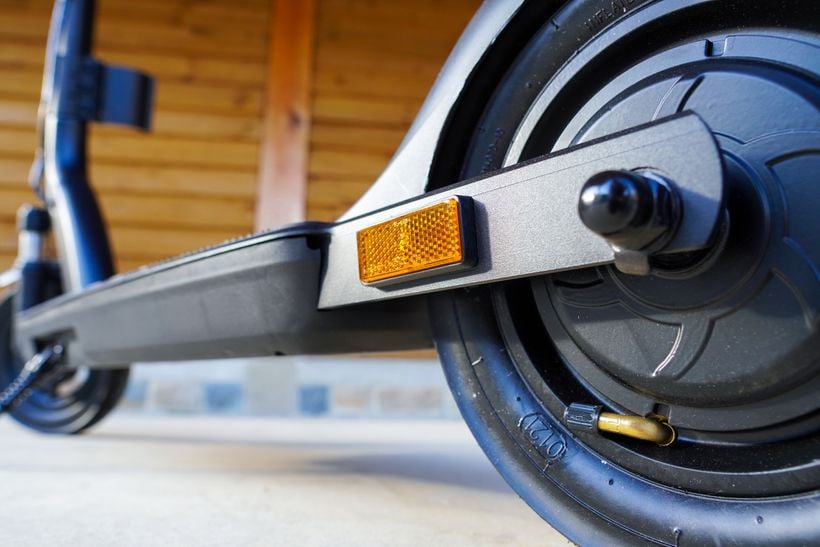
The only gripe I have with the LED setup is that – like so many scooters of its ilk – the headlight isn’t quite powerful enough for riding at night. This is, in part, down to the Pro having been built for the well-lit streets of a city environment, rather than an off-road or a country one. Stick to a well-lit urban setting, and you’ll be fine – otherwise, additional attachable lights are a must.
IPX4 Water-Resistance Rating
With an IPX4 water-resistance rating, it is certified to be resistant to splashes from every direction.
That said, I still recommend erring on the side of caution, and keeping it inside when it’s raining heavily. After all, even an IPX4 rating only gets you so far, and – considering that the warranty doesn’t cover environmental damage, such as that caused by riding in the rain – it's best to be safe than sorry.
Waterproof Electric Scooters: Best Scooters For Riding in the Rain
Smart Power Management
The battery utilizes an innovative smart power management system to safeguard it from the detrimental effects of:
- Short-circuiting
- Overheating
- Overdischarging
This system also provides overcurrent protection and uses an undervoltage auto-sleep protection feature. All this combines to give you the peace of mind that the battery has the necessary systems in place to keep it running as efficiently as possible.
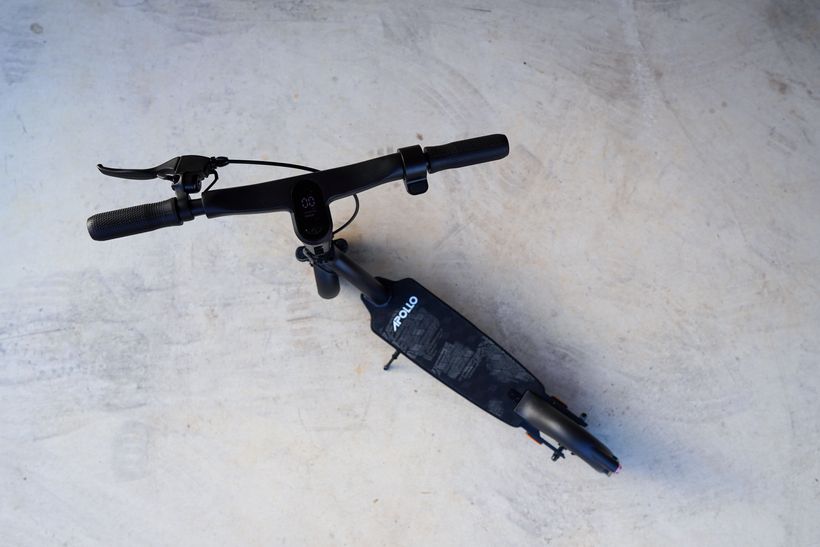
Specification: Apollo Air Pro Review
| Brand | ||||||||||||
|---|---|---|---|---|---|---|---|---|---|---|---|---|
|
||||||||||||
| Type | ||||||||||||
|
||||||||||||
| Design | ||||||||||||
|
||||||||||||
| Performance | ||||||||||||
|
||||||||||||
| Extra Features | ||||||||||||
|
||||||||||||
Warranty & Post-Purchase Support
Warranty
The Apollo Air Pro comes with a 24-month warranty. This covers an initial 12-month term, as well as an extra year during which you won’t be liable for any markup costs for replacement or repair. Should you require any additional parts – or incur any damage that isn’t covered under warranty – you can still obtain them from Apollo at wholesale price.
Despite being one of the longest warranty policies of its kind, this guarantee still comes with its fair share of the fine print. Any negligence or abuse to the scooter won’t be covered, and nor will damage deemed to be caused by improper assembly, storage, or unauthorized modifications or upgrades.
Issues that are the fault of the environment (such as poor weather, sun exposure, or water) won’t be covered, along with ‘acts of God’, poor maintenance, wear and tear, or accidents and collisions. It’s also worth noting that, when it comes to the rims, kickstand, brake calipers, and discs, you’ll need to report any defects to Apollo within the first 30 days or 10 km (6.2 miles) of use.
Post-Purchase Support
Apollo’s post-purchase support is excellent. On its site, you’ll get instant access to information, including:
- Warranty policy
- Maintenance
- Payments
- Shipping
- Servicing
- Pre-ordering
- Returns
There’s also a highly comprehensive FAQ section, an online copy of the manual available to download, and several guides to help you with setup, as well as getting to grips with the features.
While you should be able to get all the help you need via the impressive online resources I’ve listed above, failing that, you can submit a support request ticket via Apollo’s website.
For email-based help, try support@apolloscooters.co.

Apollo Air Pro: Discover What the Best-Built Budget Scooter Has to Offer
Forging unsightly seams that are all too common, especially on entry-level scooters, it eschews the clunky style that many scooters in its price bracket have with curved lines, flush finishes, and a design that flows from one section to the next. Discover what else the Air Pro has to off by watching the video.
Specification: Apollo Air Pro Review
| Brand | ||||||||||||
|---|---|---|---|---|---|---|---|---|---|---|---|---|
|
||||||||||||
| Type | ||||||||||||
|
||||||||||||
| Design | ||||||||||||
|
||||||||||||
| Performance | ||||||||||||
|
||||||||||||
| Extra Features | ||||||||||||
|
||||||||||||





